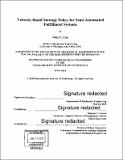Velocity-based stowage policy for semi-automated fulfillment systems
Author(s)
Liu, Amy C., S.M. (Amy Chenxi). Massachusetts Institute of Technology
DownloadFull printable version (5.223Mb)
Other Contributors
Massachusetts Institute of Technology. Department of Mechanical Engineering.
Advisor
Stephen C. Graves.
Terms of use
Metadata
Show full item recordAbstract
Online retail fulfillment is increasingly performed by semi-automated fulfillment systems in which inventory is stored in mobile pods that are moved by robotic drives. In this thesis, we develop a model that explores the benefits of velocity-based stowage policies for semi-automated fulfillment systems. The stowage policies decide which pods to replenish with the received inventory. Specifically, we model policies that account for the velocity of the units being stowed. By stowing higher (lower) velocity units on higher (lower) velocity pods, we expect to increase the heterogeneity of the pod velocities. Greater heterogeneity in pod velocities can yield a greater reduction in pod travel distance from velocity-based storage policies for the pod. Reducing pod travel distance could decrease the number of robotic drives that are needed for the system to maintain a certain throughput rate (Yuan, 2016). We consider the random stowage policy as our base case, in which the stowage decision for each unit does not depend on the unit's velocity. In comparison, we model three types of stowage policies that use the unit velocity in the stowage decision: two-class with informed stowage, M-class with informed stowage, and two-class with random stowage. For the two-class and M-class model with informed stowage, we assume that we can classify the units based on their expected velocity, and then use this information to make the stowage decisions; we develop an approximate model from which we can characterize the impact on reducing the pod travel distance compared to that of the base case. Using simulation, we verify the accuracy of the approximate model. For the two-class with random stowage policy, we assume that the units can be categorized as being either high velocity or low velocity; however, we assume that this categorization cannot be used at stowage and that the units are stowed onto the pods randomly. We assume, though, that we can categorize each pod as being a high or low velocity pod based on the number of high velocity units stowed on the pod. We use simulation to evaluate this policy. For each of the velocity-based stowage policies, we evaluate the sensitivity on the total system travel distance per hour by varying parameters, compared to that of the base case. We also evaluate the benefits of the two-class model with random stowage from the simulation, and compare with that of the two-class model with informed stowage.
Description
Thesis: S.M., Massachusetts Institute of Technology, Department of Mechanical Engineering, 2018. Cataloged from PDF version of thesis. Includes bibliographical references (pages 53-54).
Date issued
2018Department
Massachusetts Institute of Technology. Department of Mechanical EngineeringPublisher
Massachusetts Institute of Technology
Keywords
Mechanical Engineering.